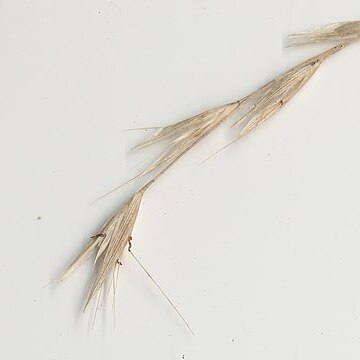Tall, slender, light green, in dense, crowded or loose tufts, shortly rhizomatous; leaves to about ½ height of culms; branching extravaginal. Leaf-sheath pale stramineous to grey-brown, rather dense or scattered short hairs; apical tuft of hairs to 2.5-(3) mm. Ligule c. 0.1 mm. Leaf-blade to 25-(35) cm, flat, to 2 mm wide, or folded and inrolled, with scattered long hairs, margins scabrid. Culm to 1 m, internodes glabrous but densely, minutely hairy to scabrid for usually c. 10 mm below inflorescence. Panicle slender, elongate, to 12 cm of few to several spikelets on short pedicels; rachis and pedicels densely short-scabrid with some longer hairs, especially below spikelets and above branch axils. Spikelets (3)-4-6-flowered, awns exserted from glumes. Glumes usually purplish centrally or near margin, lanceolate, subobtuse, 9-12-(13.5) mm, ± equal; lower 7-(9)-nerved, upper 5-(7)-nerved. Lemma 2.2-3.5 mm, 9-nerved, upper row of hairs ≥ lemma, in marginal and occasional adjacent tufts with usually two, occasionally 0 central tufts, lower row of marginal tufts not reaching to upper tufts, and shorter ± continuous to extremely sparse hairs between tufts, elsewhere glabrous or 1-2 hairs centrally; lobes 6-8.5 mm, narrowed to fine awns; central awn (9)-10-12 mm, column (2)-2.5-3.5-(4) mm. Palea 3.5-4.5-(5) mm, > upper lemma hairs, interkeel and margins glabrous. Callus 0.5-0.8-(1) mm, thick marginal hair tufts usually overlapping lower lemma hairs. Rachilla 0.5-0.6 mm. Anthers 0.5-0.7 and 1.2-1.8 mm. Caryopsis c. 2 × 0.8-1.1 mm; embryo 0.7-0.9 mm; hilum 0.3-0.5 mm.
More
Plants loosely caespitose; innovation buds extravaginal. Culms 12–64 cm high. Inflorescences linear, with few basal branches. Spikelets 7–16 mm long, with 3–6 florets; pedicels parallel to inflorescence axis. Glumes slightly to substantially exceeding florets; lower glume 7–15 mm long. Callus hairs reaching lower lemma hairs. Lemma: body 2–3.6 mm long, glabrous between the rows of tufts; upper row of hair tufts of marginal and some dorsal tufts or of only marginal tufts; lower row of tufts from a complete row to only marginal tufts, not reaching the upper row; lobes as long as body; setae 1.6–6 mm long, as long as to longer than lobes; awn 6–14.8 mm long, exceeding setae; awn column tightly twisted, equalling lobes. Palea obovate, 3–5.2 mm long, narrow, 3–5 times as long as wide, usually much exceeding lemma sinus. Anthers 0.6–2 mm long. Caryopsis 1.8–2.3 mm long.
Subalpine woodland, marshes, and grassland, and at lower altitudesoften in light shade.

